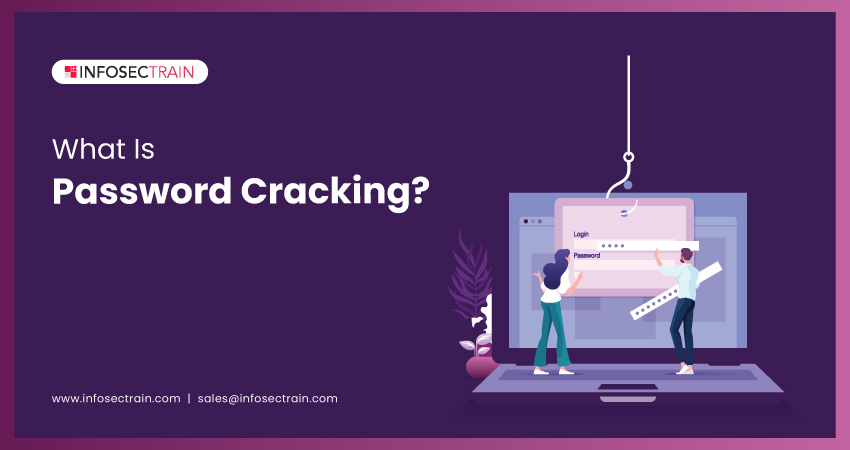What Is Password Cracking?
Password cracking attacks are constantly increasing due to the widespread use of weak passwords, poor password management practices, and the increasing sophistication of password-cracking tools and techniques used by cybercriminals. It is a serious illegal and unethical crime that can result in severe legal consequences. The risk of password cracking can cause significant harm to individuals and organizations, including data theft, financial loss, and damage to reputation. Therefore, individuals and organizations need to understand password cracking attacks and techniques. Understanding password cracking techniques can help you prioritize strong password security practices and take the necessary precautions to avoid unauthorized access to private information and resources.

What is password cracking?
Password cracking is the process that involves computational methods to guess or retrieve a password from stored or transmitted data, typically employing algorithms executed by a computer. It is often used by hackers or malicious actors to gain unauthorized access to a target computer system or online account by guessing or cracking the password. It can be accomplished for several reasons, such as gaining access to sensitive information, stealing data or resources, conducting espionage, or carrying out malicious activities. Security professionals also use this method to test the strength of passwords and identify vulnerabilities in a system’s security. However, in most cases, password cracking is done with malicious intent and is considered illegal and unethical.
How Password Cracking Works?
There are several password cracking techniques like brute force, dictionary search, hybrid, rainbow, guessing, phishing, or malware attack that can be used to crack passwords of various accounts like email accounts, social media accounts, and online banking accounts. Password crackers (hackers or cybercriminals) mainly use brute force, dictionary search, hybrid, rainbow, and social engineering attacks to identify correct passwords.
- Brute force attack: In this method, the attacker repeatedly attempts to guess a password by systematically trying every possible character combination until a valid password is found. In this attack, the attacker uses a password-cracking tool that generates a list of possible passwords. The software tool can try different character combinations, including uppercase and lowercase letters, symbols, and numerical digits, and it can also try numerous word and phrase variations that are commonly used as passwords.
- Benefits:
- Can eventually crack any password
- Effective against simple and short passwords
- Can be used against any encryption algorithm
- Drawbacks:
- Time-consuming and resource-intensive
- Ineffective against complex and longer passwords
- Can be easily detected by security systems
- Benefits:
- Dictionary search attack: In this method, the attacker uses a list of commonly used words or phrases, also known as a dictionary, to guess the password. The attacker uses a software program that automatically tests each word in the dictionary list against the password field of the target account.
- Benefits:
- Faster than brute force attacks
- Can crack simple passwords
- Uses a pre-existing list of common passwords
- Drawbacks:
- Limited to common passwords
- Ineffective against strong passwords
- Cannot crack passwords that are not in the dictionary
- Benefits:
- Hybrid Attacks: This method combines the techniques of dictionary attacks with brute force attacks. In this attack, the attacker starts with commonly used passwords or words from a dictionary and then tries variations of those words by adding every possible combination of characters like numbers, symbols, and lowercase or uppercase letters.
- Benefits:
- Faster and more effective than brute force and dictionary attacks
- Allows for variations of commonly used passwords
- Can crack passwords with some level of complexity
- Drawbacks:
- Time-consuming and resource-intensive
- May not be effective against highly complex or unique passwords
- Can be detected and blocked by some security systems
- Benefits:
- Rainbow Attacks: In this method, the attacker uses precomputed tables of encrypted passwords to look up the password for a given hash quickly. It is effective against poorly encrypted passwords.
- Benefits:
- Can quickly crack weakly encrypted passwords
- Precomputed tables allow for quick password lookups
- Can be automated and scaled to target large numbers of passwords
- Drawbacks:
- Requires a lot of processing power and storage space
- Not effective against strong passwords or well-encrypted passwords
- Precomputed tables may not include all possible passwords
- Benefits:
- Social Engineering Attacks: In this method, attackers manipulate victims into disclosing sensitive information, like passwords, by posing as a legitimate authority figure. This attack can be very effective, as they exploit human psychology and emotions rather than technical vulnerabilities.
- Benefits:
- Can be easier and faster than other methods
- Exploits human vulnerabilities
- Can bypass technical security measures
- Drawbacks:
- Requires social skills and knowledge of human behavior
- Can be time-consuming to develop and execute
- Can be unethical and illegal
- Benefits:
For creating a strong password: What to avoid?
- Do not use common passwords: Avoid using passwords like “password,” “asdfgh,” “123456”, “qwerty,” “admin,” or anything that is too obvious or commonly used.
- Do not use personal information: Avoid using personal information like your name, birthdate, address, or any other identifiable information that can be easily obtained or guessed.
- Do not use dictionary words: Avoid using words that can be found in a dictionary, as automated password-cracking tools can easily guess these.
- Do not use common character substitutions: Avoid using common substitutions like replacing “o” with “0”, “a” with “@", or “s” with “$”, as these are predictable and can also be easily guessed by automated password cracking tools.
- Do not use the same passwords: Avoid using the same password across multiple accounts, as this makes it easier for an attacker to access all your accounts if they manage to crack one password.
- Do not use short passwords: Avoid using passwords that are extremely short, as they can be easily brute-forced by automated tools. It is generally recommended to use passwords of at least 12 characters long.
How can InfosecTrain help?
If you are interested in learning about password security and how to prevent password-cracking attacks, enroll in InfosecTrain. We provide various cybersecurity training courses such as CompTIA Security+, Certified Ethical Hacker (CEH), and Certified Information Systems Security Professional (CISSP). These certifications cover a broad range of security topics like password security, authentication, cryptography, and access control, which are essential for understanding password security and guide you on how to think like a hacker.







 1800-843-7890 (India)
1800-843-7890 (India)